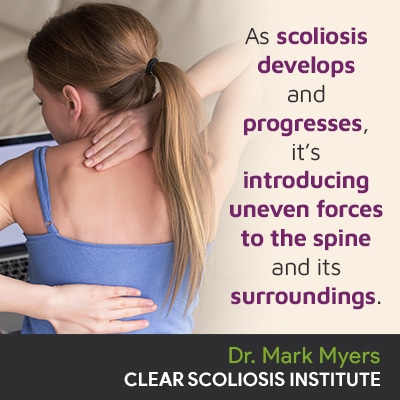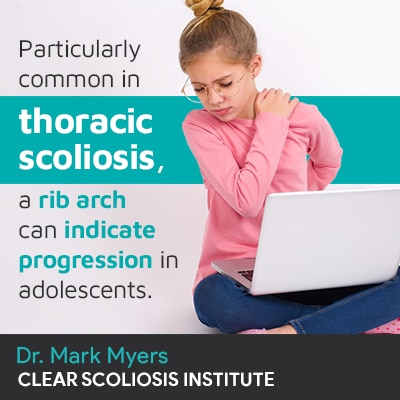
As the spine is attached to the rib cage, and scoliosis involves the development of an unnatural sideways spinal curve with rotation, as a scoliotic curve progresses, it can disrupt the natural position of the rib cage; postural changes that affect the body’s overall symmetry are among the earliest signs of scoliosis. The best way to address a rib hump/arch is by proactively treating the condition itself.
The thoracic spine (middle/upper back) is most commonly affected by scoliosis. When an unnatural thoracic curve exposes the spine and its surroundings to uneven pressure, the spine can pull on the attached rib cage, causing one side to protrude more than the other, known as a rib hump or arch.
Before discussing the specifics of rib arches and how scoliosis can disrupt the body’s overall symmetry, let’s first talk generally about the condition itself.
Scoliosis is a highly-prevalent structural spinal condition that affects close to seven million people in the United States alone.
A scoliosis diagnosis means the spine has developed an unnatural sideways curvature, with rotation, meaning the spine doesn’t just bend unnaturally to the side, but also twists from front to back and back to front, making it a 3-dimensional condition.
In addition, an unnatural spinal curve has to be of a minimum size to be diagnosed as scoliosis, meaning a Cobb angle measurement of 10+ degrees.
In a healthy spine, the vertebrae (bones of the spine) are stacked on top of one another in a straight and neutral alignment; in a scoliotic spine, the affected vertebrae are misaligned due to their unnatural tilt.
The three main spinal sections are the cervical spine (neck), thoracic spine (middle/upper back), and the lumbar spine (lower back).
While any of the spine’s sections can develop a scoliotic curve, the thoracic section, being the largest, consisting of the T1 to T12 vertebral bodies, is the most commonly affected.
A defining condition characteristic is its progressive nature, meaning it’s in the nature of scoliosis to worsen over time, especially if left untreated, or not treated proactively.
Scoliosis can range from mild to moderate and severe, and is classified on its severity scale based on a patient’s Cobb angle:

There are different types of scoliosis a person can develop, but the most prevalent is diagnosed between the ages of 10 and 18 as adolescent idiopathic scoliosis (AIS), which is the main form we’ll focus on for our current purposes.
As mentioned, scoliosis is a progressive structural spinal condition, and as such, monitoring for progression is an important aspect of treatment, as is observing how the spine is responding to treatment.
Although we don’t fully understand the etiology of idiopathic scoliosis, we know that adolescents diagnosed with scoliosis are at risk for rapid-phase progression because growth is the condition’s number-one progressive trigger, and the stage of puberty is characterized by rapid and unpredictable growth spurts.
With progression comes increasing condition severity and related symptoms, such as postural changes.
In AIS, the telltale/earliest signs of scoliosis are postural changes that disrupt the body’s overall symmetry, and these changes can range from subtle to overt, based largely on condition severity and the angle of trunk rotation (ATR).
Particularly common in thoracic scoliosis, a rib arch can indicate progression in adolescents.
Rib Hump Causes
The development of a rib arch is a common postural change that’s associated with progression.
As the rib cage is attached to the spine, as it bends and twists unnaturally (rotational component), it can pull more on one side of the rib cage than the other, causing a noticeable rib arch.
Basically, the adverse spinal tension and its disruption to the body’s overall symmetry causes the rib cage to have asymmetrical rib height; postural changes of this nature are most noticeable when in a forward-bend position.
When there is no adverse spinal tension, the spinal cord can stretch and flex to facilitate the body’s full range of movement, but when nerve tension is an issue, as it is with scoliosis, this essentially causes the spinal cord to lose height, meaning it’s pulled even tighter.
When the spinal cord is excessively tight due to adverse spinal/nerve tension, the cord attempts to counteract this with rotation, and while this rotation helps decrease the distance the cord has to travel, increasing rotation can cause the formation of a rib arch; in fact, adverse spinal tension is thought by many to be the driving force behind the onset of AIS.
So now that we know what causes a rib arch to develop, let’s address whether or not it’s painful.
Rib Hump Pain

In adolescents and children, scoliosis is not commonly associated with pain, and this is because scoliosis has yet to become a compressive condition.
In patients who are still growing and have not yet reached skeletal maturity, the lengthening motion of a growing spine counteracts the compressive force of the curvature, known to be the main cause of condition-related pain; in adults, however, their spines have settled due to gravity and maturity, making the condition compressive.
Compression of the spine and its surrounding ligaments, vessels, muscles, and nerves can cause a wide range of symptoms felt throughout the body, and while postural changes are the most noticeable symptom of scoliosis in young patients, pain is the number one reason adults come to see me for a diagnosis and treatment.
So can rib humps be painful: yes, but more so in adults. In addition, as scoliosis progresses, and particularly when severe, a rib arch can cause related complications such as lung impairment.
If thoracic scoliosis is severe, the unnatural curvature’s pull on the rib cage can increase, and as the lungs are housed in the chest cavity, the scoliotic curve can encroach upon the lung space, leaving less room to inhale and exhale fully.
Now, to be clear, this type of complication is mainly associated with severe cases, and when lung impairment does come into play, it’s often only noticeable to professional athletes who push their respiratory systems to the limit, or during times of extreme physical exertion.
Once a rib arch has developed, and particularly when lung impairment is involved, this is a type of biomechanical rib cage dysfunction that can cause varying levels of rib and chest pain, especially if left untreated.
While some might assume that scoliosis only affects the spine, as it’s such an integral structure involved in the function of virtually every working system within the body, it can produce a myriad of effects felt throughout.
While each case of scoliosis is unique, and related symptoms are determined by a number of important patient/condition variables, the most common signs of scoliosis in adolescents are postural changes that affect the body’s overall symmetry: uneven shoulders, hips, and the development of a rib arch.
As mentioned, adolescent idiopathic scoliosis is the most prevalent form, and while scoliosis isn’t commonly known as painful in young patients, it does cause postural changes, with the development of a rib arch being an indicator of progression in adolescents.
How noticeable a rib arch is will depend largely on condition severity (size of the scoliotic curve) and the angle of trunk rotation (how twisted the spine is).
In adults, once skeletal maturity has been reached and the condition becomes compressive, scoliosis can cause pain ranging from mild and intermittent to chronic and debilitating.
The development of a rib arch can occur when a scoliotic curve pulls on the rib cage and distorts its position, and when severe, this can leave less room for the lungs to function optimally, leading to rib and chest pain.
The best way to address a rib arch is to treat its underlying cause proactively: the condition itself.
As a CLEAR-certified scoliosis chiropractor, I integrate multiple treatment disciplines to work towards a curvature reduction and increasing core strength so the spine is optimally supported: condition-specific chiropractic care, a variety of therapies, and corrective bracing.
Once scoliosis is diagnosed, the best time to start treatment is always now; I see a mild curvature as a chance to keep it that way through proactive treatment.
While there are never treatment guarantees, early detection can increase the chances of treatment success and spare patients the hardships associated with increasing condition severity and related symptoms/complications.

CLEAR provides a unique and innovative way of understanding scoliosis. Sign up to receive facts and information you won’t find anywhere else.

I do not have a clear chiropractor close,is it alright to see reg chiropractor?
Hi, Beverly,
I highly recommend speaking with a CLEAR-certified doctor before going to see a regular chiropractor. They will be able to answer that question for you and will likely be able to give you suggestions. You can find a list of all CLEAR doctors on our Find a Doctor page. Please let me know if you have any other questions.
How is the Cobb measurement done on someone with scoliosis? Also I am 79 years old and have scoliosis. Would my neurosurgeon do anything besides physical therapy like surgery to correcct it?
Thank you,
Joanne
Hi, I have a 12-year daughter with scoliosis and rib hump. Before 2 years the curve was small but now it becomes a big rib hump. I'm worried because it is getting bigger. So can you give some advice.
Thank You.
Hello, Luwam,
Scoliosis is a highly progressive condition, especially at her age. Unfortunately, it will continue to progress and get bigger without some intervention. Our CLEAR Scoliosis Institute certified Doctors are trained in treating patients with this condition. They have specialized training, schooling, and specialized scoliosis equipment in their offices to help reduce and stabilize scoliosis. I suggest care sooner rather than later. The larger a curvature becomes, the more difficult it becomes to treat, so treatment as soon as possible shows the best outcome. I suggest a consultation with one of our CLEAR Scoliosis Institute certified Doctors as soon as possible to determine if she would be a candidate for treatment in their office. To find the nearest CLEAR Scoliosis Center, please visit our website under Find a Doctor. Please let us know if we can further assist you. Best of luck to you.
This post was really enlightening! I've always wondered about the connection between rib humps and scoliosis. The treatment options you mentioned give me hope, especially the emphasis on physical therapy. Thanks for breaking down a complex topic so clearly!
Thank you for this informative post! I had always wondered about the connection between rib humps and scoliosis, and your explanations really clarified things for me. The treatment options you mentioned seem promising, especially the importance of early intervention. Looking forward to learning more about this topic!